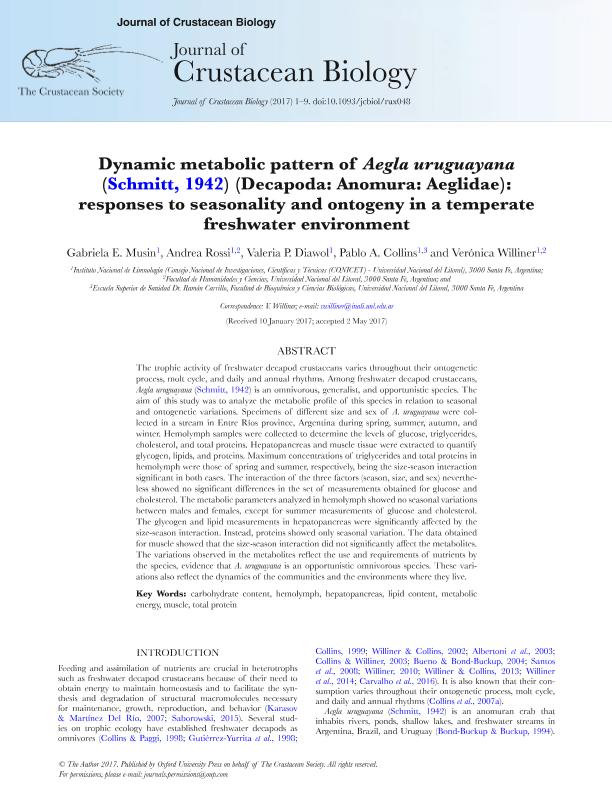Artículo
Dynamic metabolic pattern of Aegla uruguayana (Schmitt, 1942) (Decapoda: Anomura: Aeglidae): Responses to seasonality and ontogeny in a temperate freshwater environment
Musin, Gabriela Eliana ; Rossi, Andrea Silvana
; Rossi, Andrea Silvana ; Diawol, Valeria Paola
; Diawol, Valeria Paola ; Collins, Pablo Agustin
; Collins, Pablo Agustin ; Williner, Verónica
; Williner, Verónica
 ; Rossi, Andrea Silvana
; Rossi, Andrea Silvana ; Diawol, Valeria Paola
; Diawol, Valeria Paola ; Collins, Pablo Agustin
; Collins, Pablo Agustin ; Williner, Verónica
; Williner, Verónica
Fecha de publicación:
07/2017
Editorial:
Crustacean Society
Revista:
Journal of Crustacean Biology
ISSN:
0278-0372
Idioma:
Inglés
Tipo de recurso:
Artículo publicado
Clasificación temática:
Resumen
The trophic activity of freshwater decapod crustaceans varies throughout their ontogenetic process, molt cycle, and daily and annual rhythms. Among freshwater decapod crustaceans, Aegla uruguayana (Schmitt, 1942) is an omnivorous, generalist, and opportunistic species. The aim of this study was to analyze the metabolic profile of this species in relation to seasonal and ontogenetic variations. Specimens of different size and sex of A. uruguayana were collected in a stream in Entre Ríos province, Argentina during spring, summer, autumn, and winter. Hemolymph samples were collected to determine the levels of glucose, triglycerides, cholesterol, and total proteins. Hepatopancreas and muscle tissue were extracted to quantify glycogen, lipids, and proteins. Maximum concentrations of triglycerides and total proteins in hemolymph were those of spring and summer, respectively, being the size-season interaction significant in both cases. The interaction of the three factors (season, size, and sex) nevertheless showed no significant differences in the set of measurements obtained for glucose and cholesterol. The metabolic parameters analyzed in hemolymph showed no seasonal variations between males and females, except for summer measurements of glucose and cholesterol. The glycogen and lipid measurements in hepatopancreas were significantly affected by the size-season interaction. Instead, proteins showed only seasonal variation. The data obtained for muscle showed that the size-season interaction did not significantly affect the metabolites. The variations observed in the metabolites reflect the use and requirements of nutrients by the species, evidence that A. uruguayana is an opportunistic omnivorous species. These variations also reflect the dynamics of the communities and the environments where they live.
Archivos asociados
Licencia
Identificadores
Colecciones
Articulos(INALI)
Articulos de INST.NAC.DE LIMNOLOGIA (I)
Articulos de INST.NAC.DE LIMNOLOGIA (I)
Citación
Musin, Gabriela Eliana; Rossi, Andrea Silvana; Diawol, Valeria Paola; Collins, Pablo Agustin; Williner, Verónica; Dynamic metabolic pattern of Aegla uruguayana (Schmitt, 1942) (Decapoda: Anomura: Aeglidae): Responses to seasonality and ontogeny in a temperate freshwater environment; Crustacean Society; Journal of Crustacean Biology; 37; 4; 7-2017; 436-444
Compartir
Altmétricas



